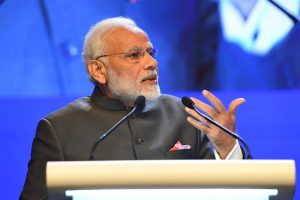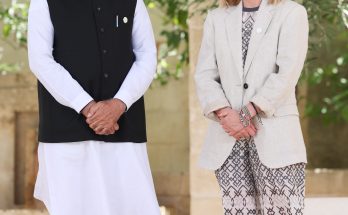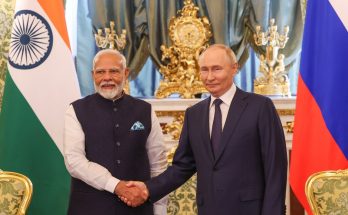
For India, the US-India joint strategic vision for the Asia Pacific and the Indian Ocean regions (agreed in January 2015) constituted a big leap in its geostrategic thinking. India has important political and economic interests in the East and Southeast Asia. India’s ‘Act East Policy’ encompasses this region. China’s sovereignty claims over the South China Sea, based on its history and the nine-dash line, have been judged without any legal foundation by the Permanent Court of Arbitration set up under the United Nations Convention on the Law of the Sea (UNCLOS).
Yet, the situation today is that several islands there have been occupied, populated and militarised by China, threatening the freedom of navigation and overflight. The Malacca Straits connect the Indian Ocean to the South China Sea, and over 40% of India’s sea-borne trade passes through it. ASEAN is one of India’s largest trade partners, and India has energy interests in countries such as Vietnam. China disputes the Vietnamese sovereignty and has objected to Indian drilling there, based on its nine-dash line claims.
STRATEGY TOWARDS THE EAST
India’s strategy towards the East is, therefore, born out of a desire to forge closer links with these countries for better economic prosperity, but also as a reaction to China’s growing control in the South China Sea and the Pacific Ocean, and also its creeping presence in the Indian Ocean. India has forged military and naval ties with countries such as Myanmar, Thailand, Indonesia, Malaysia Singapore and Vietnam. Its defence relationship with Japan and Australia is considerably advanced. The Indian Navy has taken the lead in delivering public goods, including in areas such as piracy, smuggling, terrorism, and humanitarian and disaster relief. Maritime security cooperation in the traditional and non-traditional areas has emerged as an important area of cooperation.
India is primarily an Indian Ocean country with enormous responsibilities for safeguarding its long coast line, island territories, offshore economic assets and the Exclusive Economic Zone. The trade routes between the Black Sea and the Mediterranean (in Turkey), the Suez Canal, which connects the Mediterranean and the Red Sea (in Egypt), the Bab-el-Mandeb strait (between Djibouti and Yemen) and the Hormuz Strait – the gateway to the Persian Gulf (between Oman and Iran) are of significance to India.
For India, therefore, the Indo Pacific as a concept always stretched from the East coast of Africa through the Indian Ocean till the Eastern Pacific Ocean as its geographical expanse. India’s concerns are not limited to the Bay of Bengal but also to the Arabian Sea in view of threats from the Pakistan Navy, the China-Pakistan Economic Corridor (CPEC), and development of the Gwadar Port as a logistic hub for the Chinese Navy in line with Djibouti.
CHINA’S HIGH-STAKE GAME
China’s sale of submarines to Bangladesh and port development in the nation will mean a future presence on the Bangladesh coast. Chinese submarines have surfaced at the Colombo port and Hanmantota is now under a 99-year lease to the Chinese. It has obtained Feydhoo Finolhu in the Maldives on a 50-year lease, wants unfettered access to the 1.5-degree channel and has interest in the 8-degree channel. Its ocean observatory agreement with the previous Government of Maldives at Mukhadoo Island again appeared to be a camouflage for mapping the ocean waves in order to gather vital data for submarine activity.
China is now putting pressure on Myanmar to raise China’s stake from 50% to 75-80% in Kyaukpyu port on the Bay of Bengal, and to lease it for 99 years if Myanmar does not want to pay penalty for reneging on the $3 billion Myitsone energy dam deal. It can be expected that in the future the People’s Liberation Army Navy will deploy a substantial number of ships in the Indian Ocean to ensure protection of its own sea lanes of communication.

Why western Indian Ocean matters
India has huge interests in the Western Indian Ocean region. Around 11 million expatriates from India live and work in the larger West Asia region. The country has investments in Egypt, Jordan, Saudi Arabia, Gulf Cooperation Council, and also had large investments in Yemen, Libya, Syria South Sudan and Iraq, which were affected by conflict. The region accounts for more than 70% of India’s oil and gas requirements. Indian overseas workers remit over $70 billion to India annually.
West Asian oil and gas is increasingly heading to East Asian markets like India rather than to the trans-Atlantic markets. Due to pressure from radical and extremist political forces in West Asia, most states of the region have come to value the Indian principles of seeking and securing regional stability. The Indian Navy has been deployed in the Gulf of Aden since October 2008 for anti-piracy patrol. Investments from the United Arab Emirates (UAE), Saudi Arabia, Oman, Qatar, Egypt and a few countries of the Maghreb have also started to flow into India. Saudi Arabia is now India’s strategic partner, and India has also committed itself to a geostrategic investment in Chabahar in Iran. West Asia is also a gateway for India to the land locked and energy-rich Central Asia.
In 2017, India noted at the Manama Dialogue that the four key parameters of its relations in the Gulf were being non-prescriptive, non-intrusive, non-judgmental, and not taking sides in intra-regional disputes. This has so far enabled India to have close relations with both Iran and Saudi Arabia, Israel and Palestine, and Qatar and Saudi Arabia/UAE and Bahrain.
Prime Minister Narendra Modi’s “link west” policy agenda has also evolved into “think west” with a plethora of bilateral visits. The recent decision to have an Indian defence attaché at the US naval Forces Central Command in Bahrain signalled closer collaboration with the nations in the Arabian Sea. In the western Indian Ocean, France is a valuable partner of India, given its maritime presence through a naval base at Djibouti as well as the islands of Mayotte and Reunion. India is supportive of the present US administration’s decision to rename the United States Pacific Command (PACOM) as the United States Indo Pacific Command (USINDOPACOM) in May 2018.
India’s Vision
Prime Minister Narendra Modi clearly articulated India’s vision of the Indo Pacific at the Shangri-La Dialogue in May 2018 when he said:First, it stands for free, open inclusive region, which embraces all in this geography as well as beyond who have a stake in it.
Second, South East Asia is at its centre. And ASEAN has been and will be central to its future.
Third, our common prosperity and security require us to evolve, through dialogue, a common rules-based order for the region. And, it must apply to all individually as well as to the global commons. Such an order must believe in sovereignty and territorial integrity, as well as equality of all nations, irrespective of size and strength. These rules and norms should be based on the consent of all, not on the power of a few. This must be based on faith in dialogue and dependence on force. It also means that when nations make international commitments, they must uphold them. This is the foundation of multilateralism and regionalism, and the principled commitment to the rule of law.
Fourth, we must have equal access as a right under international law to the use of common spaces on sea and in the air that would require freedom of navigation, unimpeded commerce and peaceful settlement of disputes in accordance with international law.Fifth, India stands for a free and stable international trade regime. We will support a rule based, balanced and stable trade environment in the Indo Pacific region.
Sixth, connectivity is vital. There are many connectivity initiatives in the region. If they have to succeed, we must not only build infrastructure, we must also build bridges of trust. And for that these initiatives must be based on respect for sovereignty and territorial integrity, consultation, good governance, transparency, viability and sustainability. They must empower nations, not place them under impossible debt burden. They must promote trade, not strengthen competition.
Finally, India’s own engagement in the Indo Pacific region, from the shores of Africa to that of Americas will be inclusive. We would promote a democratic and rules-based international order in which all nations, small and large, thrive as equal and sovereign. We will work with others to keep our seas, space and airways free and open, our shores secure from terrorism, and our cyber space free from disruption and conflict.
Need for Alternate Funding
To provide an alternative to the Chinese Belt and Road drive, India needs to speed up its work on its own connectivity projects such as the trilateral highway and the Kaladan Multi Modal Project, a $484 million project connecting the eastern Indian seaport of Kolkata with Sittwe seaport in Rakhine State, Myanmar by sea.
It needs to strengthen its physical (road, sea and air) as well as digital connectivity with ASEAN. It needs to work with other like-minded countries – notably Japan, Australia and the United States —– in the region. Japan, with its vision of a “free and open Indo Pacific strategy” has announced that it will commit $200 billion to the fund it had created in 2015 for a five-year period and has doubled its concessionary loans since 2015 to 1 trillion yen for connectivity projects in the region. With the help of Japan International Cooperation Agency, the Asian Development Bank has created the leading Asia’s Private Sector Infrastructure Fund (LEAP) in 2016 so that it could leverage and complement money lent to non-governmental projects.
The US has come up with initiatives like BUILD (Better Utilisation of Investment Leading to Development Act), and ARIA (Asia Reassurance Initiative Act) for connectivity and infrastructure projects in the region.
Australia has committed itself to delivering a $2 billion infrastructure initiative to the Pacific. In addition, it will deliver an extra $1 billion in callable capital to EFIC, the Australian Export Financing Agency. The US, Australia and Japan have also been coordinating to rope in the private sector for infrastructure development in the region.India has announced a $1 billion fund for physical and digital connectivity with ASEAN, and provides grants of $1 million a year to each of the 14 Pacific island states. These resources could be pooled to create alternative sources of funding.On the bilateral front, India provides assistance to its neighbours in the Indian Ocean region and has delivered a number of projects in Nepal, Myanmar, Bangladesh, Sri Lanka, Bhutan, Maldives, Afghanistan, countries on the eastern rim of Africa and also build infrastructure in the Gulf and West Asian states on contracts. It needs to improve its delivery timings, terms of lending and reliability.
India needs to continue forging links with states in the Indian Ocean region under Prime Minister Modi’s vision of SAGAR – Security and Growth for All, by entering into more cooperative arrangements of maritime domain awareness and port management of its own. Its credibility in countries of the Indian Ocean such as Maldives, Seychelles and Mauritius is high and its projects are seen as aiding the local economies.
WORKING WITH THE QUAD
Within the above-mentioned framework, India must continue to work with the Quad – revived as a loose grouping in 2017 – to reinforce the existing rule based regional order, to promote a liberal trading regime and freedom of navigation and overflight and to provide alternative sources of funding for ASEAN member states.

(Anil Wadhwa served as Secretary (East) in India’s Ministry of External Affairs. He also served as India’s Ambassador to Italy, Thailand, Oman and Poland)

(This article was first published in the Special Edition of India and the World, a pioneering magazine focused on international affairs, by India Writes Network and TGII Media Private Limited. To read the latest edition, and subscribe to India and World, write to editor@indiawrites.org)
Author Profile






